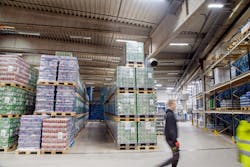Heat emission, or lack of it, is often an issue in horticultural lighting, as LEDs Magazine has repeatedly reported. But in beer making? Yes, of course!
Just ask Norway’s Aass Brewery. It replaced 400 58W T8 fluorescent tubes in its beer storage area with 400 LED luminaires from Oslo-based Glamox, and in so doing slashed its cooling bill because the LEDs emit far less heat than the fluorescent lights did.
Combined with already considerable electricity savings derived from the efficient and smart luminaires, lighting-related energy savings at the site in Drammen have exceeded 100% since the installation was completed in late 2021, according to the 189-year-old family-owned brewery.
Optimal storage temperature at the brewery is between 4°C (39°F) and 18°C (64°F).
“Energy-efficient LED lighting generates very little heat compared to fluorescent tubes,” said Aass electrician Marius Ohrvik Olsen. “This is crucial for us as heat is the enemy of brewers when storing cans of beer. We saw instant electricity savings from our new lighting, on top of which we don’t need to use our air conditioning as much. The end result is quality light with a higher light output, when and where we need it, and electricity savings in excess of 100% compared with our previous lighting.”
Aass said that energy savings from the lighting-only aspect of the job were 82%, with 43% coming from the LEDs which run more efficiently than the prior fluorescent tubes. About 39% savings were derived from a Glamox wireless control system, which deploys sensors to dim or switch off lighting when not required, and which allows remote dimming via tablet computer. The previous lighting stayed on continuously during brewery opening hours — about 5,000 hours per year.
By adding in air conditioning savings, Aass figures that the new lights have cut electricity consumption by more than 100%.
Neither Aass nor Glamox revealed how much the brewer paid for the new lighting, or how long the replacement took. The payback period is estimated at 2.4 years, based on energy prices at the time of installation in 2021, Glamox said.
The new lights are not LED tubes. Rather, they are Glamox i10 luminaires, using integrated LED boards. The long, narrow i10s were swapped straight in for the T8 tubes using existing wiring.
The replacement has positioned Aass well in the face of an EU directive coming into full force later this year that bans the sale of fluorescent tubes, although back in 2021, Aass’ motivation for the switch was energy savings, not the fluorescent ban.
“Another big bonus is that the network of new luminaires will require far less maintenance,” said Martin Rafdal, Glamox team leader on the project. “Our luminaires have long-lasting LEDs designed with an average life of 100,000 hours before they need to be replaced, compared to 12,000 hours for fluorescent tubes.”
The cooler operating temperatures bring to mind the use of LED lighting in vertical farms, where indoor growers stack greens and other other crops under cooler emitters to avoid the excessive heat of conventional high-pressure sodium lamps.
While vertical farms rely on all artificial light, greenhouses deploy artificial lighting to supplement sunlight. In greenhouse settings, the lack of heat from LEDs can sometimes prompt growers to use a mix of conventional lighting, in order to keep help keep temperatures at a certain level (follow the links in the linked story for more examples).
MARK HALPER is a contributing editor for LEDs Magazine, and an energy, technology, and business journalist ([email protected]).
For up-to-the-minute LED and SSL updates, follow us on Twitter. You’ll find curated content and commentary, as well as information on industry events, webcasts, and surveys on our LinkedIn page and our Facebook page.





